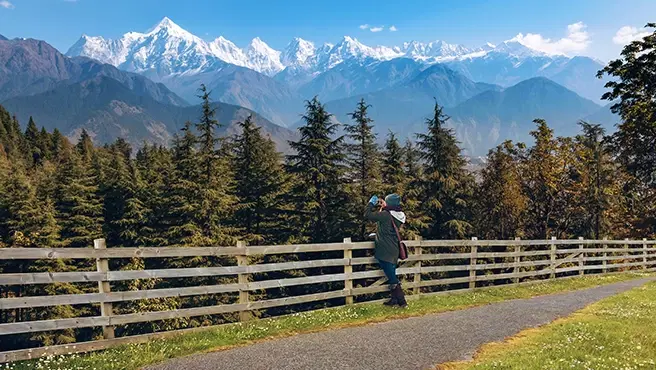
Hotels
•04 min read

India's high altitude treks offer an enchanting blend of nature and adventure. The rugged trails of the Indian Himalayan treks stir the spirit of exploration. In this blog, we answer the most common questions about high altitude treks in India. You will learn about preparation, popular routes, challenges, and expert insights. Whether you are a beginner or a seasoned trekker, this guide is designed for a safe and memorable experience in the mountains.
High altitude treks take you to places where the air is thin and nature is raw. They are a unique experience that brings both a challenge and a sense of wonder. The Indian Himalayan region is a prime destination for these adventures, and the diverse landscapes make every step an awe-inspiring journey.
High-altitude treks are routes that reach very high elevations. They often pass through rugged terrains and awe-inspiring landscapes. Trekkers experience a mix of snowy trails and alpine meadows during these journeys.
The trails in the Indian Himalayan region are filled with natural beauty. Snow-capped peaks, glistening glaciers, and winding trails make these treks special. Along with the stunning scenery, there is a deep cultural and spiritual resonance that many trekkers seek, adding depth to every step taken.
Several aspects must be kept in mind when planning a high altitude trek. Altitude sickness is a real risk and requires careful acclimatization. Your fitness level plays an important role. Weather conditions can change quickly in the mountains, so it is wise to be prepared. Simple steps like taking time to acclimatize, hydrating often, and keeping energy levels up are essential for safety and enjoyment.
The Indian landscape offers a treasure trove of high altitude trekking routes. These treks vary in difficulty and appeal, allowing every adventurer to find a perfect match.
For the experienced trekker, routes such as the Stok Kangri, Goecha La, and Rupin Pass are iconic. Each trek has a unique charm. Stok Kangri challenges your endurance with its high elevation, while Goecha La impresses with breathtaking views of snow-clad peaks. Rupin Pass offers solitude on its rugged paths.

If you are new to high altitude trekking, look towards trails like Kedarkantha, Hampta Pass, and Nag Tibba. These routes are gentle introductions to the magic of mountain treks. They provide a balanced mix of adventure and ease. Beginners can build confidence while enjoying the beauty of the Himalayas.
Snow treks are a delight for those who love winter landscapes. The Chadar Trek and Brahmatal Trek are famous examples. These treks let you experience frozen waterfalls and snowy paths. The best time to embark on these adventures is during the colder months. The crisp air and sparkling snow create a mesmerizing winter wonderland.
Preparation matters when you set out for high altitude treks in India. Your journey will be much smoother with proper fitness training, thoughtful packing, and smart acclimatization strategies.
A simple fitness routine can go a long way. Focus on activities that build endurance, leg strength, and cardiovascular health. Regular walking, jogging, and stair climbing are great for building stamina. These exercises prepare you for the physical demands of high altitude trekking.
Packing light yet effectively is key. Essentials include comfortable trekking shoes, weather-appropriate clothing, and a well-stocked first-aid kit. Remember to pack extra layers to handle temperature fluctuations. A durable backpack, water bottles, and a portable snack supply are indispensable while on the trail.
Allow your body to adjust to the changing altitude. Plan rest days and take time to acclimatize. Slow and steady progression on the trail reduces the risk of altitude sickness. Stay well-hydrated and keep an open line of communication with your guide. Knowledge on emergency measures and a respectful awareness of your limits are your best friends in the mountains.
Did You Know? The Science Behind Acclimatization
High altitudes decrease oxygen levels. Your body responds by producing more red blood cells, a process called acclimatization. Pro Tip: Practice the "climb high, sleep low" rule. This method mitigates the risk of altitude sickness and helps your body adjust.
Experts often recommend adventure treks such as Pin Parvati Pass, Kalindi Khal, and the Markha Valley. Their advice is based on both scenic beauty and the level of challenge offered. These high altitude trekking routes are celebrated for their adventurous spirit and stunning mountain views. The balance between physical challenge and natural beauty makes these paths unforgettable.
Respect for nature and local cultures is paramount. Every trekking experience carries cultural and environmental significance. Along these trails, the footprints left behind remind us to protect and cherish the pristine environment of the Himalayas.
The Stok Kangri Trek in Ladakh is one of the highest altitude treks, reaching an elevation of 20,187 feet.
Treks like Goecha La, Rupin Pass, and Pin Parvati Pass exceed 15,000 feet and offer breathtaking views.
Some high altitude treks, like Kedarkantha and Hampta Pass, can be beginner-friendly with proper preparation and guidance.
The best seasons are pre-monsoon (May-June) and post-monsoon (September-October), though it depends on the specific trek and region.
A slow pace, proper acclimatization, and staying hydrated are key. Avoid alcohol, and always follow your guide’s advice.
High altitude treks in India offer a mix of natural beauty, physical challenge, and spiritual enrichment. You can explore a range of trekking experiences, from snow treks in India to popular trails in the Indian Himalayas. Whether you choose beginner-friendly routes or challenging treks in India, preparation is key. Leave behind your worries and embrace the thrill of the mountains with the right fitness, gear, and safety tips. Your journey into the heart of nature promises not only scenic vistas but also a deeper connection with life itself. Let the call of the mountains inspire you to discover more of what the landscapes have to offer.